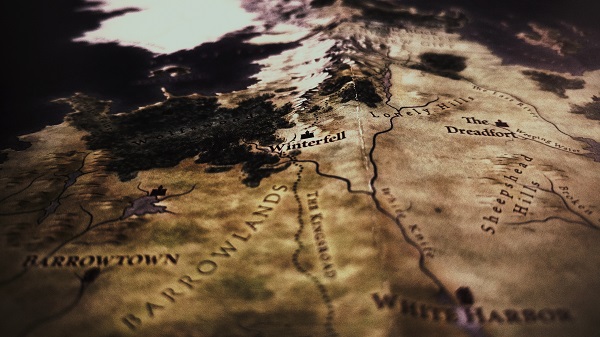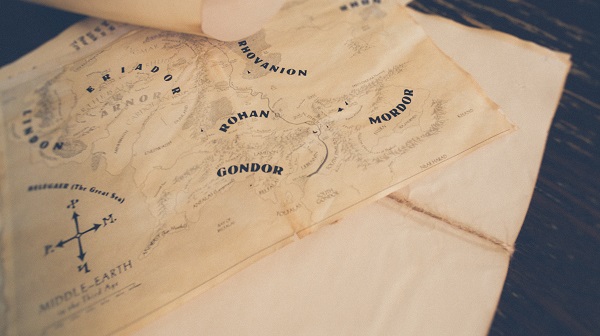If you’re currently writing, editing or getting ready to publish a fantasy novel, you might be wondering if you need to include a map.
Fantasy novels are well-known for including maps, more so than any other genre.
A map is a guide for the reader. It helps bring them into the story, keeps them grounded in the world, and stops them from losing their way.
Maps can also help writers further develop their story and world, and keep them organised as they write. But if you’re here because you’re wondering if you need a map in your fantasy novel…
Well, the answer is no. You don’t need a map just because you’re writing fantasy.
If you’re thinking of including a map in your fantasy book, ask yourself some questions:
- Does your story take place in multiple locations?
- Is it easy to get lost in your world?
- Will a map enhance the reader’s experience?
- Could a map help you as you write?
If you answered ‘yes’ to any of the above, you might think about having a fantasy map. It’s a great storytelling tool when used well, and it’s a nice little bonus for the reader.
Even if you’re writing in a genre other than fantasy, you can still add a map. Don’t hold back just because it isn’t as common.
What books typically have maps?
In fiction, fantasy novels are the most likely to have maps. Fantasy readers are used to this and may even expect it.
That’s because fantasy books are more likely to be introducing readers to a fresh new world that they haven’t experienced before.
Imagine reading an epic fantasy like A Game of Thrones without knowing where each character is based in relation to each other.
It would be easy to become confused about locations and the distance in between – and to be less engaged with the story as a result.
But fantasy isn’t the only genre of novel that can include a map. Historical fiction books may as well, as the names of places change and people of today may be unfamiliar with historical locations.
Maps in mystery books can also be useful, as it can show readers where crimes have taken place or where clues have been found. The Devil and the Dark Water, a mystery novel based on a ship, includes a map that shows us where each cabin is.
Adventure books may also include maps. The map in Treasure Island not only allows the reader to understand the location, but adds to the theme and the story, as it’s a treasure map.
Basically, any genre of book can include a map – as long as it’s necessary.
Maps may not be needed for genres like romance or contemporary fiction, for example, where locations aren’t as vital to the story, and a map wouldn’t really add anything to the theme.

What’s the purpose of a map in a novel?
A fiction book map is the same as any real-world map: it gives a big-picture view of a world, city or other location. Fantasy maps also introduce the reader to the author’s world before they’ve read a single word.
Have you ever gotten confused about the course of a character’s journey throughout a book? Or had the flow of the story interrupted as a character mentions a location and you have to work out where it actually is within the world?
With a map, the reader can flip to the front of the book, take a quick look, collect their bearings, then get back into the swing of reading. Without one, they may be left confused or less engaged with the story.
In epic fantasies like The Lord of the Rings, The Chronicles of Narnia or Robin Hobb’s Farseer trilogy, a map is essential as the story spans over a whole continent.
These stories cover many locations, each with their own individual landscape. Having a map means that the reader doesn’t get lost, and can track a character’s journey across multiple books.
Being able to track the hero’s journey can add an extra emotional layer to the story. Take The Lord of the Rings, for example.
When the Fellowship breaks up and Frodo and Sam leave the rest, we can track each group of characters as they embark on their separate journeys.
As each group of characters wonders if the others are still alive, readers know not only that they are, but that they’re much closer to one another than they realise.
This fosters extra emotion in the reader: hope that the characters may meet again, and frustration when the distance between them grows.
As well as enhancing the reader’s experience, a map is a simple tool for a writer to use when planning, writing and editing their story.
It’s a great world-building tool, helping you get a basic grasp of your world’s geography and how its environments can affect characters and their journeys.
You can keep your map beside you as a reference while you plan your character’s journey and the obstacles or challenges they may encounter.
Having a visual aid like this can help you keep ideas together in one focused area, rather than having to search through a mountain of notes.
How to know if your map is necessary
I recently read a contemporary fantasy novel based in a rather famous city. It included a map of where different buildings were. I didn’t look at it once.
I knew what these places looked like from the description the author gave and from my knowledge of the city. More importantly, I was able to imagine it without any confusion.
The map didn’t add anything to the story. So remember: not every fantasy novel needs a map.

A map may also be unnecessary if the story is based in one location. We don’t always need to know where every room or building is located, as we should be able to imagine enough through the writing itself.
For example, in the Harry Potter books, there is no need for a map of Hogwarts. We can imagine what the school looks like and gauge roughly where everything from the descriptions we’re given.
That being said, earlier I referenced the mystery book The Devil and the Dark Water, which does include a map of just one location.
In this instance, the map doesn’t feel unnecessary; it actually fits the genre well. It’s a great tool to help readers pinpoint different clues and try to work out who committed the crimes.
Should you include a map?
I generally like maps in books. It adds a nice extra layer of depth, and when I open a book I’ve just bought and there’s a map on one of the first pages, it gets me even more excited for the story.
For me, I would rather a book have a map that I don’t need rather than not having one that I might need. But I can’t tell you if you should have one in your novel – it depends on your story, your world, and your individual circumstances.
If you’re self-publishing, a map will usually involve the extra cost of commissioning someone to create it for you, so that’s worth keeping in mind.
But if you’re at this point and still wondering whether you should have one, there’s really just one last question to consider: Do you want to include a map?
This is your novel, so it comes down to personal preference.
***
Maps are a simple tool to help writers with world-building, introduce readers to a world, and enhance the overall reading experience. Let’s think again about the questions we asked at the start.
- Does your novel span across multiple locations that your reader could easily get lost in?
- Is your story based somewhere that might be new or unusual to your reader?
- Could a map enhance the reading experience and build on your story or theme?
- Will a map assist you during the process of writing and refining your novel?
- Is a map necessary for your story?
- And, most importantly, do you want a map in your book?
There’s no hard-and-fast rule about including a map in your novel. It isn’t something you should feel forced to include because it’s common in your genre, or to exclude because it isn’t.
At the end of the day, you need to choose whatever is best for the story you’re telling.